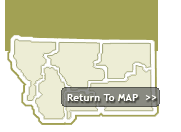

| Home | Communities | Accommodations | Places To Go | Things To Do | Site Map |
|
Glacier Country
Central Montana
Missouri River Country
Southwest Montana
Yellowstone Country
Southeast Montana
|

Fort Assinniboine Historic Site, Northern Agricultural Research CenterHavre MontanaListing Type: State Historic SiteCity: Havre Montana Region: Central Montana 406-265-4000 http://ag.montana.edu/narc/fort.htm |  More Images |
Fort Assinniboine Historic Site was constructed in 1879, and became the largest military fort west of the Mississippi River. The post had 104 buildings and was contained within a 40 mile long by 15 mile wide military reservation. Several of the original buildings still stand. It became a state agricultural experiment station in 1911, and continues so today.
The primary mission of the Fort's garrison was to prevent attacks from the some 5,000 Lakota Sioux Indians led by Sitting Bull, and other chiefs who had fled to the safety of Canada after the Battle of the Little Big Horn. The fort served as a base for patrols along the Canadian border and the Milk River Valley. Fort Assinniboine became the state's military head quarters, with the responsibility of maintaining control over the Blackfoot Confederacy and other northern Montana Indian Reservations. The most famous soldier to serve at the Fort was John J. Pershing, who was assigned to the post in 1896. He commanded H Troop, the Black 'Buffalo Soldiers' of the 10th Cavalry.
Guided tours are available on an appointment basis. Tours originate at the H. Earl Clack Museum, located at corner 3rd Street and 3 Avenue, in Havre. Otherwise, entry to the Fort grounds for historical sightseeing is not allowed.
Directions: Fort Assinniboine Historic Site is located six miles southwest of Havre, Montana, on US Highway 87 at the Northern Agricultural Research Center
.Today, guided tours are available on an appointment basis. Tours originate at the H. Earl Clack Museum, located at corner 3rd Street and 3 Avenue, in Havre, Montana. Otherwise, entry to the Fort grounds for historical sightseeing is not allowed.
Fort Assinniboine Historic Site, Northern Agricultural Research Center
Montana Highway 87, Havre, MT 59501
|
A source for Montana Travel & Tourism Information
![]()